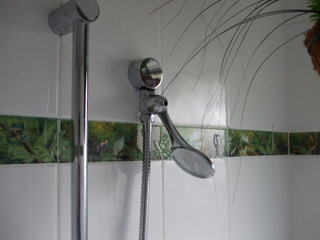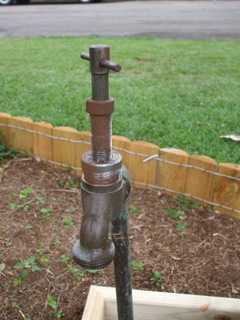Conducting a Water Audit - Part 1
Created: 2011-08-28 07:17:12
After years of skirting around it, I decided to undertake a Permaculture Design course that is offered by a friend of mine and it covers all sorts of things that are dear to the heart of those who wish to live more sustainably. One of the subjects covered is water and one of the things you have to do as part of the course is conduct a water audit. I thought that I had a handle on how much water we used and where it went as well as the opportunities for improvement, but there is nothing to make you get your head out of your backside like a load of hard data. If you want to get your head out of your bum regarding water use then read on, and once you have read follow the process. I actually found it fun.
What is a Water Audit?
A water audit is a tool that allows you to work out how much water you use and where it all goes and if you do it right, it doesn’t allow you much squirming room but that is the point. The water audit itself has a number of stages –
- Identify the areas where your household uses water and work out the typical amount for each use
- Conduct the audit by recording over a week the amount of water you use
- Validate your workings against the records from your water supplier
- Identify any leaks that will introduce inaccuracies to your figures
- Work out how much water you have coming onto the property through rain and can be stored
- Work out how much greywater you have available for re-use.
- Work out how much tank capacity you need for water security
In the “resources” section of this site there is a form to help you work through the process and record all of this information and in a second article we will discuss what use can be made of all this information you will amass.
Identifying and Quantifying Sources of Water Use
There are a whole stack of ways we can use water in our houses so here is a list the water uses we have and some of the things you might want to think about as you identify them. You will also need to know how much water is consumed by each use so that you can calculate your water consumption –
Toilet – this is a pretty obvious one. If you have a dual flush system you will need to give some thought as to how often each one is used. If you don’t know how much water is used in each flush then have a look at any documentation you have when the toilet was installed, otherwise consult the internet like I did.
Shower and bath – these can be a bit difficult because the number and length will not only vary from person to person but may also vary with the time of year, more in summer and less in winter. Also when you wash your hair the showering time will be longer and the water use increased, so we divided the shower readings into hair washing and non-hair washing so we could get a more accurate reading. Otherwise you just might want to work out an average and use that.
If you get hold of a calibrated bucket (ie it has litre markings on the side) you can run the shower into the bucket for a minute and see how much water comes out. After that you just have to time the showers to know how much water is used on average. You can pull the same stunt for the bath or use the internet again to find out the volume of your make and model, then make a judgement on how full the bath is and so how much water is consumed.
Dish washing – water use will depend on the size of your family, who eats at home and when and whether you use a dishwasher or do the dishes by hand. If you use a dishwasher then the water consumption should be on the paperwork under specifications or consult the internet again. For hand washing we ran as much water into the sink as we would normally use then dipped it back out of the sink and into the calibrated bucket (see shower and bath above!) to give us a measure of how much we used.
Clothes washing – this will depend on the type of machine you have, although if you still go for the beat-the-clothes-against-the-rock style of clothes washing estimating water usage will be difficult, otherwise look up your user’s manual or use the internet to find out.
Teeth brushing and had washing – this is probably a minor thing unless you leave the tap running while you brush your teeth! We set each of them at 1 litre per wash/brush but if you want to get more detailed than that it is up to you. It was interesting to note just how many times a day we washed our hands, a legacy of watching too many hand cleaner commercials I think.
Drinking and cooking – this is likely to be variable depending on the size of your household, what and how you like to cook, what and how much everybody drinks etc. After some to and fro we settled on 7 litres per day as a reasonable compromise but you may wish to do your own research on this one.
In the garden – This will depend on what time of year you conduct your audit and how long it has been since your last rain. If all else fails some kind of estimate may work but you should measure the output of every tap you use to water your yard, lawn, garden, veggies etc by running them into a calibrated bucket to identify how many litres per minute of water is delivered by the hose. Then you will need to measure, or estimate, how many minutes you spend watering the garden to give you an idea of how many litres of water are used each time.
Conducting the Audit
This is the simple bit, although it will require you to remember to record each water use at the time that you use it, but after a while you will get in the swing. Estimates are possible but there is nothing quite so educative and reviewing the tallies at the end of the week, you may well discover something that you wouldn’t have thought credible, if you hadn’t done the recording.
First off, download a copy of the blank Water Audit Form from the “Resources – Sustainable Living” section of this website and print it out. Then record all of your estimates for each use after the “@” in each of the sections of the right hand “Water Use” column.
Put the printed sheet up somewhere that you can get to it easily to enter your tallies, the kitchen or bathroom would probably be best, then each day mark of with tally marks in the appropriate square each time you wash, flush water or whatever or add in the number of minutes used where it is a consumption figure.
There is no saying that you only have to do this for only one week and you may want to do this several time over the year, say once each season, and the more times you do it, the more accurate your water usage figures will be.
Once your measuring period is complete, add the figure totals up along the bottom and down the right hand side and then calculate your total litres for the week, then multiply by 52 and you will have some idea of how much water you use in a year.
Validating Your Results
As a cross check, get hold of your last four (quarterly) water bills and then add them up to give a yearly total, just to see how close it is to your calculated total. If you don’t have your last four water bills (who does?) you can ring up your provider and they will usually be able to give you a litre consumption figure over the phone. If your figure is wayyyyyy out, re-check the things you are measuring to see if you have missed something or if you have cut back water consumption just because you are measuring it. If you can’t find a reason for the discrepancy you may (and assuming the consumption on your bill is larger than on your measured tally) have a leaking pipe somewhere and that is something worth pursuing.
Checking For Leaks
If you do think you have a leak, turn off all water in the house and write down the figure on you water meter. Leave everything off for as long as you can manage but at least two hours and then re-check the figure on your water meter, if it has changed you have a leak and need to obtain the services of a plumber, unless you are capable of tracking such things down yourself.
Part 2 - a bit more measuring, and what to do with the results.
